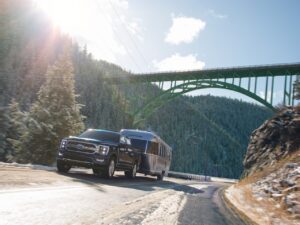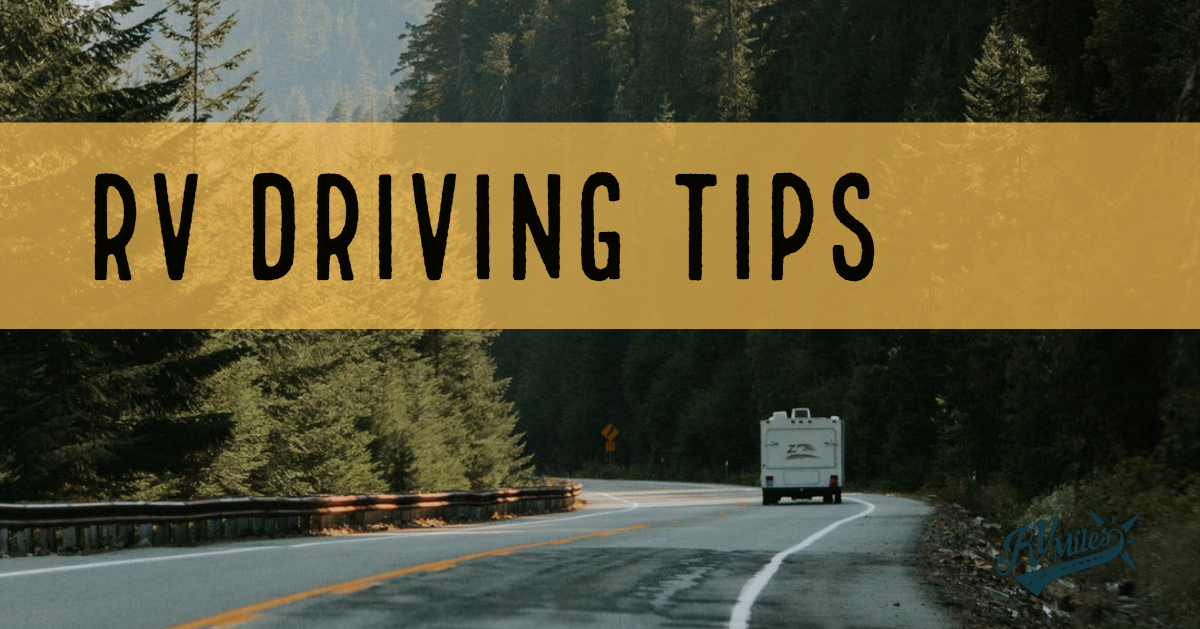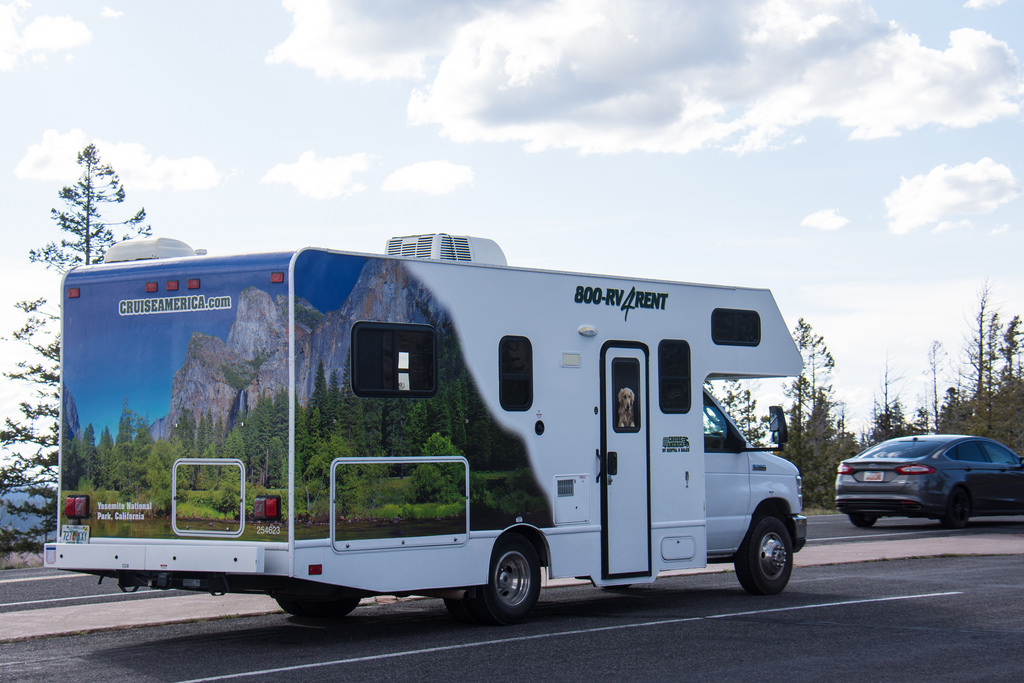
Whether you’re traveling full-time or looking to be a weekend warrior camper, every RVer needs to know a few basic facts before cruising the open road. Here are 9 basic RV driving tips every first-timer (and seasoned RVer too!) should know. For a more in-depth discussion, check out Episode 47 of the RV Miles Podcast.
Go Slow
Don’t be embarrassed to drive well under the speed limit on the highway. In fact, in many places, the towing speed limit is 5-10mph less than the posted limit. It can be easy to feel pressure from other drivers to cruise at 70+ mph, but the fact of the matter is, slower is safer when you’re in an RV, and many trailer tires are not rated for speeds over 65 mph. This may not seem very fast, but remember, you are in a large moving object and it is hauling or pulling a lot of stuff. And yes, you’ll probably encounter drivers who want you to speed up, however, your safe driving speed is more important. This applies to two-lane highways as well. Do not feel the pressure of a line of cars behind you, and yet, also recognize that when you can, you should utilize a pull-off and safely pull over to let the cars pass you. You are making safe choices on the road, and if they want to speed up and go around you, they most certainly can. Do not risk your safety for an impatient driver or two.
Oh, and another benefit of going that slow, even speed? You get better gas mileage.
Know Your Size
From tunnels to overpasses, to bridges, to campsites with specific length requirements, an RV roadtrip is full of all kinds of interesting size requirements, so it’s important to know exactly how tall, long and wide your RV is before you get on the road.
A great tip to find the height of your RV is to lay a 2 X 4 on top of the highest point on the roof (most likely the a/c unit). Then take your measuring tape and go from the 2 x 4 to the ground. Do this on both sides and take the average, especially if you are parked in an uneven parking lot or driveway. Having an exact idea of your height will ensure you don’t end up in a pickle when encountering bridges or overpasses.
Be a Courteous Driver
An RV is no place for road rage. From changing lanes to allowing people on from the highway entrance ramp, to who goes first at the four-way stop, RV drivers will always find the trip more enjoyable and safe when recognizing they are the bigger, and sometimes more intimidating vehicle on the road. Flip your turn signal on a little early just so everyone knows your next move, keep to the middle or right lane (the right lane is preferred), do not cut people off on the highway because you want to go around a slower-moving truck or RV, and if you need merge give people time to make room for you. Be mindful of what may upset you as a driver, and do your best to avoid those kinds of situations.
 Lane Centering
Lane Centering
An RV is a wide vehicle, so being mindful of where you are in your lane is crucial to keeping you and everyone around you safe. This can be a little tricky in the beginning, but eventually, you’ll get used to your width and how to line yourself up in your lane. A handy trick is to find a spot on your dashboard that can help serve as a center lane marker.
Stick to the Right Lane
It’s always a good idea to stay in the right lane, especially in the early days of driving an RV. By being in the right lane you give yourself space to figure out width and lane position since you have the shoulder on your right-hand side, and speaking of the shoulder, being in the right lane allows you to safely pull off should you experience a technical issue. You also feel less pressure going at a safe, possibly slower speed, than the rest of the highway traffic in the right lane, plus you have the best visual access from your driver’s side mirror. Being in the right lane does mean you’ll need to be more aware of entrance ramps, but as long as you stay courteous, slow down for those wanting to enter, and move safely to the middle lane from time to time, you should have no issue with cruising right along in the right lane.
Keep Your Distance
Tailgating other vehicles should not be in an RVers vocabulary. Keeping a safe distance from the vehicle in front of you allows you to brake in plenty of time without causing harm on the road. Remember, an RV needs more time to come to a safe stop than a smaller-sized vehicle, and if you are riding someone’s tail and they suddenly break, you will end up in an accident.
A recommended safe distance is 400 feet (or 4 seconds), but even better if you can be 500 feet (or 5 seconds). You will have drivers slide in and fill the spot, but that’s alright. You just slow down and put distance between you and this new driver. If you’re driving at a safe speed, they most likely won’t be in front of you long. At the end of the day, you need to be able to safely brake should the unexpected happen, so give yourself the space to do just that.
You’d be surprised at how different braking in an RV is from braking in a car. RVs can be very heavy, and it takes a lot to stop all of that inertia. There is really no such thing as a sudden stop when hauling a few tons or more. This is why maintaining a stopping distance is so important.

Grades
Braking on long downward grade heats your brakes up, and if they get too hot, you may lose them altogether. Downshift and let your engine do as much of the braking as possible. The increased engine resistance in a lower gear will help slow your vehicle down while reducing the wear and tear on your brakes. If you have an engine/exhaust brake, use it! Using short, hard stabs at the brakes instead of steady pressure is the best way to keep them from burning up.
Turning
RVs are long and wide, which means an RVs turns will be long and wide, too. Especially right turns since you’ll be up against the curb and the radius is smaller. To safely turn your RV, watch your rear-view mirrors and keep as close to the center of the lane as you can, and most importantly, take your time. Don’t worry about the traffic behind you, and don’t take a right on red unless no one is around. Learn about your pivot point and tail swing, and watch it in the mirrors as you turn. Your pivot point is your rear axle. You generally can’t begin your turn until your rear axle is clear of obstructions. Tail swing is the portion of your vehicle behind your pivot point — your rear overhang — that swings the opposite direction when you turn. It’s important you understand the tail swing of your RV before you find yourself driving downtown Chicago during rush hour, and the best way to do that is to practice before you get on the road. Find an empty parking lot and spend some time practicing, using the white lines as guides. A spotter can help tell you what you’re about to hit.
Parking
While you’re practicing turning, practice backing up and parking. If you’ve never driven a trailer before, backing it up can be the most challenging part of learning to drive it. But once you get the hang of it, you’ll be a pro in no time. Just remember that your trailer turns the opposite direction as your steering wheel when backing up. Use a spotter to help you park, or get out and assess it yourself.
For a more in-depth discussion on the tips mentioned above, check out Episode 47 of the RV Miles Podcast. You can also take a look at some of the excellent videos








